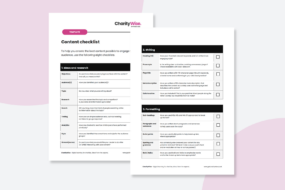

For content creators, planning and researching blog posts can be a time-consuming process. If your charity has limited time or resources, AI-powered tools like ChatGPT can help to streamline your content creation process.
Whilst it isn’t a replacement for the creative work that writers do, ChatGPT can increase efficiency by helping you to plan, research, and draft content.
What is ChatGPT?
ChatGPT is a natural language processing tool that is powered by artificial intelligence (AI). It can be used for various tasks such as generating topic ideas, assisting with writing, and repurposing content.
There are several other AI language tools available such as Gemini and Jasper, but ChatGPT is the most well-known model.
How to use ChatGPT
ChatGPT is useful to have in your digital toolkit if you know how to use it to your advantage.
With all AI language tools, human intervention is still key. You need to input relevant text prompts or instructions so that ChatGPT can generate useful responses. These prompts provide context and help the tool understand the purpose of your query. The more specific you are with your prompts, the better the results you’ll get.
Here are just some of the ways that you can use ChatGPT to streamline your content creation process:
New topic ideas
ChatGPT can be used in the brainstorming stage to generate topic ideas and titles for your blog posts. You can focus on an overarching topic area or search for sub-topics to help you think about the bigger picture.
Just remember to add as much context as possible, as the more detailed your prompts are, the better the results.
Prompt examples:
- ‘Generate 5 new topic ideas about X’
- ‘Give me sub-topics related to X’
- ‘Think like someone hiring a freelance writer to write blogs about X. Give me five topics you would want the freelance writer to cover’
Keyword generation
After you have generated some new topic ideas, you can use ChatGPT alongside your SEO tool of choice to find relevant keywords.
Simply request ChatGPT to generate keywords related to a specific topic area or your blog post idea. You can specify whether you want to look at short or long tail keywords and ChatGPT will generate a bulk list of relevant keywords.
Next, use an SEO tool (such as SEMRush, Ahrefs etc) to look at the search volume and keyword difficulty of the suggested keywords, before deciding which keywords to focus on in your blog post.
Prompt examples:
- ‘Make a list of short tail keywords for a blog post called X (blog title)’
- ‘Suggest some long tail keywords for a blog post about X (blog topic)’
Creating content briefs
ChatGPT can also be used to create content briefs to guide the writing process.
Content briefs provide a basic structure and information on what to include in the blog. You can use the brief as a starting point and writers can include additional information where needed.
Prompt examples:
- ‘Create a content brief for an article about X’
- ‘Provide the basic structure of an article about X’
Conducting research
If you are researching different topic areas or looking for answers to specific questions, you can use ChatGPT to provide a clear and concise overview of the topic.
It is also useful when summarising complex information such as reports, studies, and web pages into a more digestible format.
Prompt examples:
- ‘Explain the importance of X’
- ‘Summarise this blog post (URL)’
Creating meta descriptions
When you have written your blog post, you can use ChatGPT to create a relevant meta description.
Meta descriptions provide a short summary of your web page’s content and help search engines understand the topic of your page.
You can also provide extra information in your prompt for keywords to include and character count.
Prompt examples:
- ‘Create a meta description for this content (URL), including the keyword X’
- ‘Write a meta description for X topic, including the keyword X, ensuring that the character count does not exceed X’
Repurposing content
Repurposing content is a great way to reuse all or some of the parts of an existing piece of content to expand its reach.
You can repurpose a written blog post into different formats so that you are getting the most out of your content. For instance, you can repurpose a blog into a video script or social media post etc.
It’s important to add as much context and information about your audience as possible, to get the desired results.
Prompt examples:
- ‘Repurpose this blog post (URL) into a short video script that focuses on X themes’
- ‘Repurpose this blog post (URL) into a post for LinkedIn that encourages people to X’
ChatGPT is an effective tool to use when planning and researching content. And over time, you’ll get to grips with writing clear prompts to get the most out of it.
Just remember, ChatGPT is not a replacement for human writers – always make your own judgements when using the tool.




